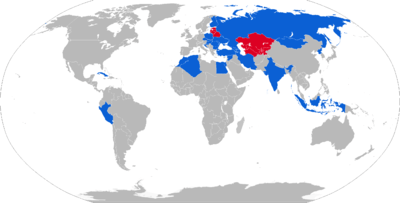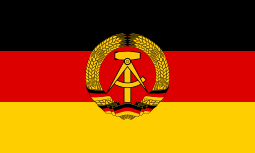9M113 Konkurs
| 9M113 Konkurs | |
|---|---|
|
9M113 Konkurs missile | |
| Type | Anti-tank missile |
| Place of origin | Soviet Union |
| Service history | |
| In service | 1974–present |
| Used by | See operators |
| Production history | |
| Designed | 1970 |
| Manufacturer | Tula Machinery Design Bureau (Tula KBP) – Tulsky Oruzheiny Zavod |
| Variants | 9M113M |
| Specifications | |
| Weight | 14.6 kg (32 lb) |
| Length |
1,150 mm (45 in) 875 mm (34.4 in) without gas generator |
| Diameter | 135 mm (5.3 in) |
| Warhead | 2.7 kg (6.0 lb) 9N131 HEAT |
Detonation mechanism | Contact |
|
| |
| Engine | Solid-fuel rocket |
| Wingspan | 468 mm (18.4 in) |
Operational range | 70 m (230 ft) to 4 km (2.5 mi) |
| Flight ceiling | - |
| Speed | 200 m/s (660 ft/s) |
Guidance system | Wire-guided SACLOS |
Steering system | Two control surfaces |
Launch platform | Individual, vehicle |
The 9M113 Konkurs (Russian: 9М113 «Конкурс»; cognate of French: Concours; English: "Contest") is a SACLOS wire-guided anti-tank missile of the Soviet Union. "9M113" is the GRAU designation of the missile. Its NATO reporting name is AT-5 Spandrel.
Development
The 9M113 Konkurs was developed by the Tula Machinery Design Bureau (Tula KBP). Development began with the aim of producing the next generation of SACLOS anti-tank missiles, for use in both the man-portable role and the tank destroyer role. The 9M113 Konkurs was developed alongside the 9M111; the missiles use similar technology, differing only in size. The warhead penetration is 600 mm vs rolled homogeneous armour (RHA).
The missile entered service in 1974. Iran began producing a copy, the Tosan (not to be confused with the Toophan), sometime around 2000.[1][2]
Description


The missile is designed to be fired from vehicles, although it can also be fired from the later models of 9M111 launchers. It is an integral part of the BMP-2, BMD-2 and BRDM-2 vehicles. The missile is stored and carried in a fiberglass container/launch tube.
The system uses a gas generator to push the missile out of the launch tube. The gas also exits from the rear of the launch tube in a similar manner to a recoilless rifle. The missile leaves the launch tube at 80 meters per second, and is quickly accelerated to 200 meters per second by its solid fuel motor. This initial high speed reduces the missile's deadzone, since it can be launched directly at the target, rather than in an upward arc. In flight, the missile spins at between five and seven revolutions per second.
The launcher tracks the position of an incandescent infrared bulb on the back of the missile relative to the target and transmits appropriate commands to the missile via a thin wire that trails behind the missile. The system has an alarm that activates when it detects jamming from a system like Shtora. The operator can then take manual control, reducing the missile to MCLOS. The SACLOS guidance system has many benefits over MCLOS. The system's accuracy is quoted in some sources as 90%, though its performance is probably comparable to the BGM-71 TOW or later SACLOS versions of the 9K11 Malyutka.
Models
- 9M113 Konkurs (NATO: AT-5 Spandrel, AT-5A Spandrel A)
- 9M113M Konkurs-M (NATO: AT-5B Spandrel B) Tandem warhead – with extended explosive probe. The warhead penetration is 750–800 mm vs RHA. Adopted in 1991.[3]
- Tosan Iranian-built missile [1]
Operators


Current operators
-
 Algeria[4][5] – used by mechanized infantry units
Algeria[4][5] – used by mechanized infantry units -
 Armenia[6]
Armenia[6] -
 Azerbaijan
Azerbaijan -
 Egypt – mounted on Fahd armoured personnel carriers purchased in 1990s
Egypt – mounted on Fahd armoured personnel carriers purchased in 1990s -
 Bulgaria
Bulgaria -
 Croatia[7]
Croatia[7] -
 Cuba – not confirmed
Cuba – not confirmed -
 Czech Republic
Czech Republic -
 Finland – known as PstOhj 82M, fired from 9P135M-1 launchers (withdrawn from service)
Finland – known as PstOhj 82M, fired from 9P135M-1 launchers (withdrawn from service) -
 Georgia[8]
Georgia[8] -
 Hungary
Hungary -
 Indonesia – mounted on BVP-2 infantry fighting vehicles operated by the marine corps
Indonesia – mounted on BVP-2 infantry fighting vehicles operated by the marine corps -
 India – 15,000 Konkurs-M, ordered in 2008 for Rs 1,380-crore.[9][10] Another 10,000 Konkurs-M ordered for US$250 million.[11]
India – 15,000 Konkurs-M, ordered in 2008 for Rs 1,380-crore.[9][10] Another 10,000 Konkurs-M ordered for US$250 million.[11] -
 Iran manufactures its own version, upgraded and high explosion named Tosan.
Iran manufactures its own version, upgraded and high explosion named Tosan. -
 Morocco
Morocco -
 Mongolia
Mongolia -
 Moldova – used on BRDM-2
Moldova – used on BRDM-2 -
 North Korea – produced domestically
North Korea – produced domestically -
 Peru – used by Navy infantry
Peru – used by Navy infantry -
 Poland
Poland -
 Romania
Romania -
 Russia – about 300 Konkurs-M complexes delivered annually in the last years (2014)[12]
Russia – about 300 Konkurs-M complexes delivered annually in the last years (2014)[12] -
 Slovakia
Slovakia -
 Turkey
Turkey -
 Syria
Syria -
 Ukraine
Ukraine
Former operators
-
 East Germany – produced in licence, passed on to Germany, and later phased out of service.
East Germany – produced in licence, passed on to Germany, and later phased out of service. -
 Czechoslovakia – produced in licence, passed on to successor states.
Czechoslovakia – produced in licence, passed on to successor states. -
 Soviet Union – Passed on to successor states.
Soviet Union – Passed on to successor states.
See also
References
- 1 2 http://modlex.ir/cgi-bin/store.pl/page=product.html/pid=MXF05-000060
- ↑ Chistopher F. Foss, Jane's Defense Week, Another ATGW for IranAnother ATGW for Iran at the Wayback Machine (archived December 5, 2004)
- ↑ http://rbase.new-factoria.ru/missile/wobb/concursm/concursm.shtml
- ↑
- ↑ http://www.army-technology.com/projects/kornet/[]
- ↑ Old missiles not so old after all – Russia Today, October 12, 2011.
- ↑ Bojevo gađanje polaznika SVO u Pješačkoj pukovniji, Croatian Ministry of Defence, Feb 29, 2012
- ↑ Georgian Land Forces October 12, 2008.
- ↑ Pandit, Rajat (Aug 17, 2010), "India to order large number of Javelin anti-tank missiles from US", Times of India
- ↑ Pandit, Rajat (Jan 27, 2009), "India goes for 'urgent' purchase of anti-tank missiles", Times of India
- ↑ "CCS Clears USD 250 Million Konkur Missiles for Army". DefenceNow. 2012-10-26.
- ↑ http://vpk-news.ru/news/22778
Sources
- Hull, A.W., Markov, D.R., Zaloga, S.J. (1999). Soviet/Russian Armor and Artillery Design Practices 1945 to Present. Darlington Productions. ISBN 1-892848-01-5.
External links
| Wikimedia Commons has media related to 9M113 Konkurs. |
- ATGM launcher vehicle "KONKURS" (BRDM-2) – Walk around photos
- AT-5 SPANDREL Anti-Tank Guided Missile
- PTRK Konkurs (Russian)
